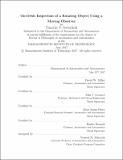On-orbit inspection of a rotating object using a moving observer
Author(s)
Setterfield, Timothy P. (Timothy Philip)
DownloadFull printable version (13.43Mb)
Other Contributors
Massachusetts Institute of Technology. Department of Aeronautics and Astronautics.
Advisor
David W. Miller, John J. Leonard, Alvar Saenz-Otero and Emilio Frazzoli.
Terms of use
Metadata
Show full item recordAbstract
Many objects in space such as orbital debris, defunct satellites, and natural objects are uncooperative, meaning that they are not equipped with working sensors or actuators. There are several reasons to want to visit these uncooperative space objects with an inspector satellite: to deorbit or deflect dangerous debris; to inspect and/or repair defunct satellites; or to observe, sample, or extract resources from natural objects such as asteroids and comets. After performing orbital rendezvous with the target object, the first phase of proximity operations involves observing the object from a safe distance and planning the subsequent phases. This thesis focuses on observing the target object during the first phase of proximity operations. Its objective is to develop a framework and efficient algorithms to obtain a sufficiently detailed and accurate estimate of the target's structure and dynamics to serve as a platform to plan and execute the subsequent mission objectives. Specifically, subsequent phases will require an estimate of the target's rotational motion model to facilitate path planning, a 3D map for relative pose determination, and the inertial properties of the target to aid in stabilization of its spin. Since the dynamics of the target and inspector may have similar time constants, the trajectory of the inspector must be estimated to disambiguate the motion of the target from that of the inspector. The algorithms presented in this thesis require that the inspector satellite be equipped with a star tracker, an inertial measurement unit, and a dense 3D visual sensor such as stereo cameras or LiDAR. The inspector trajectory is estimated in a manner which is independent of target motion, using a factor graph approach. Here, star tracker orientation measurements, gyroscope and acceleration measurements, and range and bearing measurements to the target's centroid are input as factors into a trajectory factor graph. Taken together, these measurements make the inspector's trajectory observable. Mapping is performed by estimating the inspector's trajectory in an arbitrary target-fixed frame. Frame-to-frame matching and visual odometry are used to find pose constraints and build a pose graph. In addition to adding pose constraint factors between successive frames, loop closure is performed between temporally non-adjacent frames. A kinematic constraint on the target-fixed frame, resulting from rigidity of the target object, is exploited to create a novel rotation kinematic factor. This factor connects the inspector trajectory factor graph with the mapping pose graph, and facilitates the estimation of the target's center of mass. Map creation is performed by transforming detected feature points into the target-fixed frame, centered at the estimated center of mass. Inertial properties estimation is performed for passive targets through constrained optimization of principal axes orientation and inertia ratios. Firstly, finite differencing of orientation estimates from trajectory estimation and mapping is used to determine the polhode of the target object. Estimation of the principal axes is performed by calculating the body frame orientation for which ellipses and hyperbolas optimally fit the projections of the polhode onto the principal planes. Given the polhode in the target's body frame, constraints are formed which restrict the feasible inertia ratios to a single degree of freedom. Optimization along this degree of freedom is used to find the inertia ratios which optimally predict the observed polhode. Trajectory estimation and mapping algorithms are implemented in C++, and inertial properties estimation is implemented in MATLAB. Experimental data is acquired from the SPHERES-VERTIGO test platform on the International Space Station. Simulated data is acquired using SPHERES dynamics simulation and Blender 3D rendering software. Comparison of the resulting estimates with ground truth validates that the algorithms produce accurate results. Analysis of the algorithms' computational performance reveals that their computational cost is negligible when compared with that of the requisite onboard image processing.
Description
Thesis: Ph. D., Massachusetts Institute of Technology, Department of Aeronautics and Astronautics, 2017. This electronic version was submitted by the student author. The certified thesis is available in the Institute Archives and Special Collections. Cataloged from student-submitted PDF version of thesis. Page 214 blank. Includes bibliographical references (pages 207-213).
Date issued
2017Department
Massachusetts Institute of Technology. Department of Aeronautics and AstronauticsPublisher
Massachusetts Institute of Technology
Keywords
Aeronautics and Astronautics.